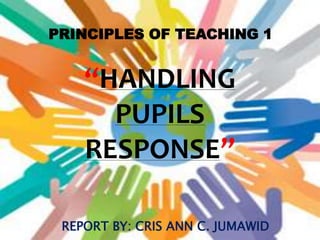Handling Pupils Response
•Download as PPTX, PDF•
3 likes•2,375 views
As a teacher, it is important to be able to handle the students' responses correctly because the way you handle the responses of students can affect the way the students receive corrections. Accepting mistakes and correction is crucial when it comes to the students so it is advised that the teachers be able to handle them properly.
Report
Share
Report
Share

Recommended
Recommended
More Related Content
What's hot
What's hot (20)
Catering Diverse Learners through Multigrade Teaching

Catering Diverse Learners through Multigrade Teaching
Performance-Based Assessment (Assessment of Learning 2, Chapter 2))

Performance-Based Assessment (Assessment of Learning 2, Chapter 2))
Similar to Handling Pupils Response
Similar to Handling Pupils Response (20)
The art of questioning an essential skill for successful teaching.

The art of questioning an essential skill for successful teaching.
Strategies to Address Needs of Struggling Students

Strategies to Address Needs of Struggling Students
Recently uploaded
God is a creative God Gen 1:1. All that He created was “good”, could also be translated “beautiful”. God created man in His own image Gen 1:27. Maths helps us discover the beauty that God has created in His world and, in turn, create beautiful designs to serve and enrich the lives of others.
Explore beautiful and ugly buildings. Mathematics helps us create beautiful d...

Explore beautiful and ugly buildings. Mathematics helps us create beautiful d...christianmathematics
This presentation was provided by William Mattingly of the Smithsonian Institution, during the third segment of the NISO training series "AI & Prompt Design." Session Three: Beginning Conversations, was held on April 18, 2024.Mattingly "AI & Prompt Design: The Basics of Prompt Design"

Mattingly "AI & Prompt Design: The Basics of Prompt Design"National Information Standards Organization (NISO)
APM Welcome
Tuesday 30 April 2024
APM North West Network Conference, Synergies Across Sectors
Presented by:
Professor Adam Boddison OBE, Chief Executive Officer, APM
Conference overview:
https://www.apm.org.uk/community/apm-north-west-branch-conference/
Content description:
APM welcome from CEO
The main conference objective was to promote the Project Management profession with interaction between project practitioners, APM Corporate members, current project management students, academia and all who have an interest in projects.APM Welcome, APM North West Network Conference, Synergies Across Sectors

APM Welcome, APM North West Network Conference, Synergies Across SectorsAssociation for Project Management
Recently uploaded (20)
Beyond the EU: DORA and NIS 2 Directive's Global Impact

Beyond the EU: DORA and NIS 2 Directive's Global Impact
Explore beautiful and ugly buildings. Mathematics helps us create beautiful d...

Explore beautiful and ugly buildings. Mathematics helps us create beautiful d...
Mattingly "AI & Prompt Design: The Basics of Prompt Design"

Mattingly "AI & Prompt Design: The Basics of Prompt Design"
Z Score,T Score, Percential Rank and Box Plot Graph

Z Score,T Score, Percential Rank and Box Plot Graph
Ecological Succession. ( ECOSYSTEM, B. Pharmacy, 1st Year, Sem-II, Environmen...

Ecological Succession. ( ECOSYSTEM, B. Pharmacy, 1st Year, Sem-II, Environmen...
Measures of Dispersion and Variability: Range, QD, AD and SD

Measures of Dispersion and Variability: Range, QD, AD and SD
APM Welcome, APM North West Network Conference, Synergies Across Sectors

APM Welcome, APM North West Network Conference, Synergies Across Sectors
This PowerPoint helps students to consider the concept of infinity.

This PowerPoint helps students to consider the concept of infinity.
Handling Pupils Response
- 1. PRINCIPLES OF TEACHING 1 “HANDLING PUPILS RESPONSE” REPORT BY: CRIS ANN C. JUMAWID
- 3. In providing corrective feedback: * Remember that the reaction “That’s wrong” can put off or embarrass a learner. Be more tactful. * Give a hint or break down the question if necessary, to guide the learner to the correct response.
- 4. * Explain the correct answer when the learners cannot arrive it all. * Initially ask easy questions to enhance the student’s (particularly a slow one’s) self-confidence and to encourage active participation from everyone.
- 5. ◦ 2. GIVING APPROPRIATE PRAISE TO HIGH QUALITY RESPONSES.
- 6. In giving appropriate praise: * Match praise to the level of difficulty of the question answered or to the quality of the response given. * Very acceptance reactions. As someone said, there are 99 ways of saying “okay”.
- 7. ◦ * Remember that a slow/insecure learner needs more praise than a fast/confident one. Be discreet, lest the faster ones think that praise is only for the slow learners.
- 8. ◦ 3. MAKING FOLLOW UP QUESTIONS
- 9. In making follow up questions: * Remember that follow up questions should logically relate to the preceding questions and/or the learners response.
- 10. * Follow-up questions should be characteristically developmental and directed towards a better/deeper understanding of the topic being discussed. * Clearly-stated, short follow-up questions elicit better responses from the students.
- 11. Redirecting Questions ◦ * Certain questions observe to be answered by more than one learner. Take advantage of this opportunity to promote creative or divergent thinking.
- 12. * Some students need a re- formulation of the question for better understanding. Be sensitive and accommodating to such need.
- 13. 5. FOLLOWING-UP A STUDENT’S RESPONSE WITH RELATED QUESTIONS.
- 14. In explaining the question/answer: * Slowly repeating or replacing certain words in a question may be the way to enable a student to give the correct answer.
- 15. 6. REPHRASING THE SEEMINGLY UNCLEAR QUESTION ◦ * Rephrase unclear questions by using terms or idioms familiar to the student. * Avoid long and complicated sentence structures in asking questions.
- 16. 7. SHOWING NON-VERBAL ENCOURAGEMENT. In showing nonverbal encouragement: * Body language, particularly a teacher’s facial expression during recitation communicates a message of encouragement or otherwise to students. * Eye-to-eye contact, a smiling face, and an encouraging hand gesture remove fear of embarrassment from the students.
- 17. 8. ENCOURAGING LEARNERS TO ASK QUESTIONS ◦ * Watch out for students who seem to have problems(via nonverbal indicators) about certain responses. Encourage them to bring out their questions. (Source: SEAMEO INNOTECH. The Interactive Instruction Series for Teacher Education, Trainor’s Manual on The Art of Questioning and Reacting Techniques,1994)